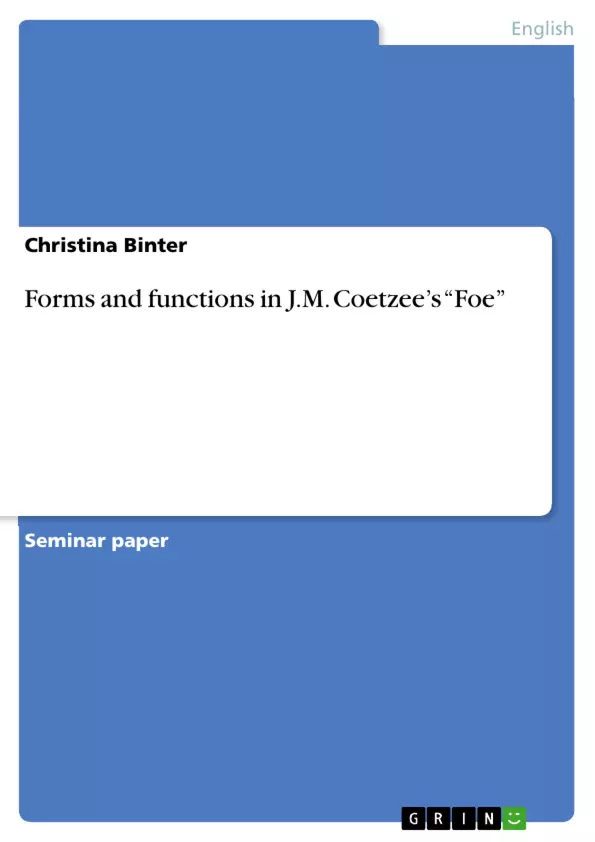The main aim of this seminar paper is to introduce the novel “Foe” by J. M. Coetzee and to give an overview about the forms and functions of it. Therefore, a closer look at metafiction, historiographic metafiction and meta-narrative techniques is necessary, due to the fact that the novel is “meta-narrative”.
Since the story of the island, narrated by the protagonist Susan Barton, is important for an analysis, it is not enough just to focus on that. Susan’s island story serves as a kind of framework because the novel is about “the art of writing and story-telling”.
Firstly, the author, J. M. Coetzee, his biography and his many works will be presented. Secondly, the term metafiction, its definition and different forms will be discussed. After that there will be a short overview of the novel, including plot, characters and narrative techniques, which are important to understand the meaning of the book. This will be followed by the chapter “metafiction”, in which some forms of metafiction as well as some elements of the story, supported by some examples, will be presented.
The final section will give an overall picture of Coetzee’s story “Foe”.
Inhaltsverzeichnis (Table of Contents)
- Introduction
- About the author
- Metafiction
- Definition
- Forms of Metafiction
- Coetzee's work "Foe"
- Plot
- Characters
- Narrative techniques
- Metafiction, meta-narrative techniques and historiographic metafiction in “Foe”
- Part one
- Part two
- Part three
- Part four
- Conclusion
- Bibliography
Zielsetzung und Themenschwerpunkte (Objectives and Key Themes)
This seminar paper delves into the novel "Foe" by J.M. Coetzee, providing a comprehensive overview of its forms and functions. The paper examines metafiction, historiographic metafiction, and meta-narrative techniques, essential aspects of the novel's "meta-narrative" structure. The analysis focuses on the interplay between the island story narrated by Susan Barton and the broader theme of the art of writing and storytelling, exploring the novel's unique narrative framework.
- Metafiction and its role in contemporary literature
- The interplay of narrative levels and the construction of reality in "Foe"
- J.M. Coetzee's unique writing style and his use of meta-narrative techniques
- The exploration of history and memory through the lens of fiction
- The relationship between author, reader, and text in postmodern literature
Zusammenfassung der Kapitel (Chapter Summaries)
- Introduction: This chapter introduces the seminar paper's focus on "Foe" by J.M. Coetzee and outlines the analysis of metafiction, historiographic metafiction, and meta-narrative techniques. It emphasizes the novel's "meta-narrative" approach and how Susan Barton's island story functions as a framework for exploring the art of writing and storytelling.
- About the author: This chapter presents a brief overview of J.M. Coetzee's biography, highlighting his work as a computer scientist, linguist, and postmodernist novelist. It discusses his use of narratological approaches, including metafiction, and his sensitivity to the complexities of representing black people in his South African context. The chapter also touches on the diverse interpretations of Coetzee's writing style, exploring the debates surrounding his approach to the political situation in apartheid South Africa and his focus on language.
- Metafiction: This chapter defines the term "metafiction" and explores its various forms, laying the groundwork for understanding its significance in Coetzee's "Foe". It examines how metafiction can be found throughout literary history, encompassing the relationships between authors and readers, fiction and criticism, and art and life.
- Coetzee's work "Foe": This chapter provides an overview of "Foe", introducing the plot, characters, and narrative techniques that are crucial to understanding the novel's meaning. It sets the stage for the subsequent chapters, which delve deeper into the interplay of metafiction, meta-narrative techniques, and historiographic metafiction within the story.
Schlüsselwörter (Keywords)
Key concepts explored in this seminar paper include metafiction, historiographic metafiction, meta-narrative techniques, postmodern literature, J.M. Coetzee, "Foe", narrative levels, storytelling, and the construction of reality. The paper investigates the unique ways in which these concepts are interwoven in Coetzee's novel, revealing its complex and multifaceted nature.
- Quote paper
- Christina Binter (Author), 2017, Forms and functions in J.M. Coetzee’s “Foe”, Munich, GRIN Verlag, https://www.grin.com/document/1247272



